Health and Physical Education
The fifth grade health and physical education objectives reflect the Virginia Standards of Learning. Instruction reinforces the Standards of Learning in the core subject areas.
Motor Skill Development
- Performs fundamental motor skills and specialized movement patterns
Anatomical Basis of Movement
- Uses cognitive information to enhance motor skill acquisition and performance
Fitness Planning
- Communicates the knowledge to achieve and maintain a health-enhancing level of fitness
Social Development
- Expresses and uses responsible personal and social behaviors in activity settings
Energy Balance
- Uses health concepts related to health promotion and improvement of personal health
Personal Health
- Demonstrates the ability to access, evaluate and use health information to recognize the relationship between personal behavior and personal health
|
5th Grade Health and Physical Education |
||||
|
Essential Questions |
How do I collaborate with my peers? How will I demonstrate mature skilled movements? How do I make healthy nutritional choices? |
|||
|
Unit Title and Quarter |
Quarter 1 |
Quarter 2 |
Quarter 3 |
Quarter 4 |
|
From the Bottom Up: Building a foundation to stay healthy and fit. |
Data Driven: Utilize data to design SMART goals and FITT plans |
Make Good Choices: Practicing to build and maintain healthy behaviors and lifestyles. |
Ready, Set, Reflect: Reflect on goals and focus on lifelong skills. |
|
|
Image Cue |
 |
 |
 |
 |
|
Focus of the Story |
To start our journey to the next level of fitness and personal health we will participate in a variety of skilled activities that allow us to improve these concepts. We will also practice ways to have students communicate and collaborate to establish classroom expectations. |
We continue to build on classroom expectations that students help establish and the fitness data that we collect. We can use the data to make SMART goals and Fitness Plans to improve personal health. |
We will combine our knowledge of healthy nutrition, fitness and movement concepts to improve our overall health and wellness. |
Toward the end of the year, we begin practicing middle school HPE skills like analyzing our SMART goals and reflecting on fitness practices. These skills and activities will lead to lifelong health and physical activity. |
|
Transfer Goals |
Demonstrate socially responsible behavior to include respect for themselves, others, and the environment in thoughts, words, and actions. Describe the major parts of the body and how to care for them to improve or maintain personal health. Collaborate through activities and games, developing social and competitive skills, improving physical fitness, and increasing ability. |
Analyze data and use goal-setting skills to identify appropriate choices to enhance well-being. Analyze diverse sources and perspectives to make thoughtful judgments regarding physical and mental health decisions. Apply knowledge of bone and muscle movement to articulate movement in a variety of patterns, and spaces for health, enjoyment, or challenge. |
Identify internal and external factors that affect community, physical, emotional, and social health and generate possible solutions. Analyze diverse sources and perspectives to make thoughtful judgments regarding physical and mental health decisions. |
Collaborate through activities and games, developing social and competitive skills, improving physical fitness, and increasing ability. Analyze data and use goal-setting skills to identify appropriate choices to enhance well-being. |
|
Learning Targets |
I can dribble a ball with my hands or feet while moving in space. I can use teamwork and collaboration while working safely with peers. I can analyze the effects of smoking, vaping, and drugs on my body and relationships with others. I can perform fitness tests and analyze my scores. |
I can create a SMART goal and Fitness plan based on my fitness data. I can create and perform a rhythmic sequence of movements. I can identify the organs of major body systems. I can identify specific muscles and bones for different movements. |
I can explain the importance of eating in moderation while making healthy drink and food choices. I can demonstrate proficient striking skills with hands and implements. I can describe the benefits of physical activity and sleep. |
I can analyze my fitness scores and reflect on my SMART goal. I can participate in a variety of recreational activities and explain how they lead to lifelong health and fitness. |
Family Life Education
The Family Life Education (FLE) program for the Virginia Beach City Public Schools is a part of the FLE Virginia Standards of Learning and is taught by a fifth grade teacher. The focus is on human growth and development and appropriate boundaries. An opportunity is provided for parents or guardians to opt their children out of the FLE program if they do not wish their children to participate in some or all of the program lessons. Display copies of the program curriculum, including a description of the resource materials used, are available for review at all public schools. Resource materials are available electronically at the request of parents or guardians. For further information, call the coordinator of health and physical education, Department of Teaching and Learning at (757) 263-1070.
Instructional Technology
The fifth grade Digital Learning Integration Standards offer children a variety of instructional technology experiences based on the Profile of a Virginia Graduate. These standards are comprehensive statements that explain foundational knowledge, skills, and experiences aligned to the grade 3-5 curriculum standards.
Empowered Learner: Students leverage technologies, including assistive technologies, to take an active role in choosing, achieving, and demonstrating competency in their learning goals informed by the learning sciences.
Digital Citizenship: Students recognize the rights, responsibilities, and opportunities of living, learning, and working in an interconnected digital world, and they act in ways that are safe, legal and ethical.
Knowledge Constructor: Students critically curate a variety of digital resources using appropriate technologies, including assistive technologies, to construct knowledge, produce creative digital works, and make meaningful learning experiences for themselves and others.
Innovative Designer: Students use a variety of technologies, including assistive technologies, within a design process to identify and solve problems by creating new, useful, or imaginative solutions or iterations.
Computational Thinker: Students develop and employ strategies for understanding and solving problems in ways that leverage the power of technological methods, including those that leverage assistive technologies, to develop and test solutions.
Creative Communicator: Students communicate clearly and express themselves creatively for a variety of purposes using appropriate technologies (including assistive technologies), styles, formats, and digital media appropriate to their goals.
Global Collaborator: Students use appropriate technologies, including assistive technologies, to broaden their perspectives and enrich their learning by collaborating with others and working effectively in teams locally and globally.
Essential Information Literacy Skills (EILS)
The fifth-grade Essential Information Literacy Skills (EILS) enhance student experiences for developing skills in information literacy, inquiry, collaboration, and engaging with knowledge products safely and ethically. These skills are achieved through the collaboration of the classroom teacher and the library media specialist (LMS).
Inquire: Build new knowledge by inquiring, thinking critically, identifying problems, and developing strategies for solving problems.
- Develop and revise questions about topics that interest the student
- Make a plan to find needed information
- Create a product to show learning and act on feedback to improve the product
- Participate in an ongoing inquiry-based process
Include: Demonstrate an understanding of and commitment to inclusiveness and respect for diversity in the learning community.
- Evaluate print and digital information resources for bias and point of view
- Interact with a diverse group of peers in a respectful manner and by sharing their perspectives
- Use digital tools to connect with a variety of learners
Collaborate: Work effectively with others to broaden perspectives and work toward common goals.
- Actively listen in a group and work with others to solve problems
- Use a variety of communication tools and resources
- Break down complex problems into smaller steps
Curate: Make Meaning for oneself and others by collecting, organizing, and sharing resources of personal relevance.
- Identify possible sources of information.
- Evaluate print and digital resources and make critical choices about information
- Collect information representing diverse perspectives
- Assess the validity and accuracy of information
- Access and evaluate information resources before sharing
- Ethically use and repurpose others’ work
- Use digital tools to collect, analyze and reflect on accuracy resources or relevant data sets
Explore: Discover and innovate in a growth mindset developed through experience and reflection.
- Develop and satisfy personal curiosity by reading widely and deeply in multiple formats and writing for a variety of purposes
- Solve problems through cycles of design and implementation. Persist in self-directed pursuits
- Develop innovative means of investigation and collaboratively identify innovative solutions
- Problem solve through reflection and revision; be open to feedback
Engage: Demonstrate safe, legal, and ethical creating and sharing of knowledge products independently while engaging in a community of practice and an interconnected world.
- Follow ethical and legal guidelines for gathering and using information by complying with the school division’s Acceptable Use Policy
- Evaluate information for accuracy, validity and appropriateness
- Recognize the importance of citing sources
- Ethically use, cite, and reproduce others’ work to avoid plagiarism
- Keep personal digital identity safe and be aware of the lasting effect of their digital footprint
Art
The elementary art program is designed as a concept-based, sequential curriculum that makes connections between art and life through the disciplines creative process, critical thinking and communication, history, culture and citizenships, innovations in the arts, technique and application and the core curriculum.
Fifth grade art develops concepts and skills essential to appreciating art, creating art and making reasoned judgments about artwork. Examination of artworks enables students to explore art as a major form of inquiry and communication. By studying the disciplines of art history, aesthetics, art criticism and art production, students develop an understanding of the role of art in society. Students participate in an art class each week that is taught by an art teacher.
Creative Process
- Applies the creative process through inquiry, investigation, generating ideas, testing solutions, refining and reflecting on process and product
Critical Thinking and Communication
- Demonstrates an understanding and appreciation that art can have diverse values, meanings and definitions; uses appropriate vocabulary and communication when responding to works of art
History, Culture and Citizenship
- Demonstrates an understanding that art is a reflection of time, place and culture, and identifies the value and reasons for creating art within communities
Innovation in the Arts
- Understands and applies the artistic process, problem-solving skills, current and emerging technologies while making connections to visual arts careers
Technique and Application
- Uses artistic skills and techniques when developing ideas for creative expression through a variety of media
Storyboard
Essential Questions: What Are the Big Issues About Art? How and Why Do We Make Art? How Does Art Relate to History and Culture? How Do We Respond to Works of Art?
|
Unit Title and Quarter |
QUARTER 1 |
QUARTER 2 |
QUARTER 3 |
QUARTER 4 |
||
|
What is Art? |
World Around Us |
Culture & Tradition |
Innovation & Animation |
|||
|
Image Cue |
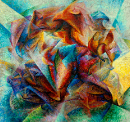
Umberto Boccioni, Dynamism of a Soccer Player (dinamismo di un footballer), 1913. Oil Painting |

Daniel Dancer, Beluga Peacemaker, 1989. |

Keisai Eisen, Carp, ca. 1800s. Woodblock print. |
Jim McNeill, Skateboarder, 2006. |
||
|
Focus of the Story |
We begin by starting our journey by asking “What is art” and building on the definition we have started to form throughout the elementary years. We look to this as a foundation of the purpose of our journey in the art classroom. |
Once we understand the beginning steps, we can continue observing the world around us and how artists are inspired by their environments, nature, and current events. We can look at personal connections of community and cultural backgrounds to build the foundation and share our stories. |
Now, we can start to think more deeply about our own culture and traditions and how we, as artists, can record who we are in our own work. Artists are often inspired by different cultures, traditions, celebrations and customs. They serve as a foundation of what and why we create as artists. |
Finally, we can start to recognize how art reflects the technology and innovation of today’s world. We can collaborate to create a positive art experience and recognize our own strengths. Challenging us to see art through various lenses. |
||
|
Transfer Goals |
The Creative Process Apply creative process through inquiry, investigation, generating ideas, testing solutions, refining, and reflecting on process and product while developing a personalized portfolio exhibiting original voice and vision as an artist. History/Culture/Citizenship Explore and understand historical influences of art through the work of self and others while cultivating an awareness that art is a reflection of time, place and culture. Students identify and interact with art as a community member and citizen, developing a lifelong engagement with art as a supporter, advocate, creator, and informed viewer. |
Critical Thinking & Communication Understands and develops an appreciation that art can have diverse values, meanings, and definitions while recognizing multiple responses and perspectives. Effective at receiving and articulating ideas using appropriate vocabulary and communication when responding to works of art. Able to work independently and collaboratively. Innovation in the Arts Understands and applies the artistic process, problem-solving skills, current and emerging technologies while making connections to visual arts careers. Technique and Application Uses artistic skills and techniques when developing ideas for creative expression through a variety of media. |
Critical Thinking & Communication Understands and develops an appreciation that art can have diverse values, meanings, and definitions while recognizing multiple responses and perspectives. Effective at receiving and articulating ideas using appropriate vocabulary and communication when responding to works of art. Able to work independently and collaboratively. History/Culture/Citizenship Explore and understand historical influences of art through the work of self and others while cultivating an awareness that art is a reflection of time, place and culture. Students identify and interact with art as a community member and citizen, developing a lifelong engagement with art as a supporter, advocate, creator, and informed viewer. Innovation in the Arts Understands and applies the artistic process, problem-solving skills, current and emerging technologies while making connections to visual arts careers. Techniques & Application Able to transfer and apply knowledge of artistic skills and techniques when developing ideas for creative expression through a variety of media. |
Critical Thinking & Communication Understands and develops an appreciation that art can have diverse values, meanings, and definitions while recognizing multiple responses and perspectives. Effective at receiving and articulating ideas using appropriate vocabulary and communication when responding to works of art. Able to work independently and collaboratively. History/Culture/Citizenship: Explore and understand historical influences of art through the work of self and others while cultivating an awareness that art is a reflection of time, place and culture. Students identify and interact with art as a community member and citizen, developing a lifelong engagement with art as a supporter, advocate, creator, and informed viewer. Innovation in the Arts Understands and applies the artistic process, problem-solving skills, current and emerging technologies while making connections to visual arts careers. Techniques & Application Able to transfer and apply knowledge of artistic skills and techniques when developing ideas for creative expression through a variety of media. |
||
|
Learning Targets |
As an artist, I can: Creatively thinking and using different processes to make art. Express personal ideas through artistic choices of media, techniques, and subject matter. Problem solve and be resourceful to solve problems creatively. Formulate questions about works of art. |
As an artist I can: Explore ways artmaking skills are used for problem-solving. Use craftsmanship with attention to detail. Apply a different media, materials, techniques, and processes including sculpture, ceramics, and craft for works of art. Create works of art inspired by a variety of ideas, subjects, and content areas. Processes. |
As an artist, I can: Explore different cultures and historical influences of art. Describe how criteria used to assess the importance of art may change over time. Look at the influence of historical events on works of art. Describe similarities and differences among art and artists from different cultures and experiences. Compare and contrast contemporary and historical works of art, including architecture. Use craftsmanship with attention to detail through use of different media, materials, techniques for sculpture, ceramics, and craft. |
As an artist, I can: Use skills and techniques when developing ideas using a variety of media. Explore approaches to time-based media, traditional animation, and game design. Demonstrate skills needed to work collaboratively in an art community. Effectively use communication skills in class discussions and presentations. Recognize a variety of strengths in others and oneself in the art classroom. |
||
Music
The Virginia Standards of Learning for Grade Five General Music enable students to use their music knowledge and skills to synthesize information and create music. Students continue to read, write, and compose music, using increasingly complex rhythms and meters. Students document questions about music and explore sources for investigating music concepts. They begin to develop choral skills, including singing in two- and three-part harmony. Students explore and perform a variety of music styles and develop personal criteria to be used for describing and analyzing musical performances. Students continue to develop recorder-playing skills. Students participate in a weekly music class taught by a music specialist.
Creative Process
- Improvise and compose music
- Apply a creative process for music
Critical Thinking and Communication
- Analyze music
- Describe how music evokes personal ideas and emotions
- Demonstrate collaboration and communication skills for music rehearsal and performance
History, Culture, and Citizenship
- Explore historical and cultural aspects of music
- Describe roles of music and musicians in communities
- Identify appropriate sources for listening to music
Innovation in the Arts
- Identify how individuals create music
- Identify how music can be created using technology tools
- Identify relationships between music and other fields of knowledge
Technique and Application
- Demonstrate music literacy
- Develop skills for individual and ensemble singing performance
- Develop skills for individual and ensemble instrumental performance
- Classify, perform, and count rhythmic patterns
- Understand and apply the difference between melodic rhythm and steady beat using body percussion, instruments and voice
- Respond to music with movement
Chorus
The elementary school chorus provides unique opportunities for students whose aptitudes and interests include expanding and refining their vocal and choral abilities. Emphasis is placed on reading music, tone production, blend, intonation, ensemble singing and incorporating choral techniques and vocal skills from the 4th and 5th Grade General Music curriculum. Students will be provided the opportunity to experience a variety of vocal styles and literature. Students participate in a weekly chorus class taught by a music specialist.
Orchestra
The Virginia Standards of Learning for Elementary Instrumental Music enable students to begin receiving instruction on a wind, percussion, or string instrument of their choice with guidance from the music teacher. Students identify parts of the instrument and demonstrate proper instrument care, playing posture, instrument positions, fingerings, embouchure, and tone production. Music literacy skills are emphasized as students read, notate, and perform music. Students begin to respond to, describe, interpret, and evaluate works of music both as performers and listeners. Students use a creative process to identify and apply the skills involved in creating original work. Opportunities are provided for students to participate in local events as appropriate to level, ability, and interest. Students are usually expected to provide their own instruments and supplies. Students participate in two weekly orchestra classes taught by a music specialist.
Creative Process
- Create music as a means of individual expression
- Apply a creative process for music
Critical Thinking and Communication
- Analyze, interpret, and evaluate music
- Formulate and justify personal responses to music
- Identify and demonstrate collaboration and communication skills for music
History, Culture, and Citizenship
- Explore historical and cultural influences of music
- Explore the functions of music, including the use of music as a form of expression, communication, ceremony, and entertainment
- Identify intellectual property as it relates to
music
Innovation in the Arts
- Identify career options in music
- Identify ways in which culture and technology influence the development of music and musical styles
- Identify the connections of instrumental music to the other fine arts and other fields of knowledge
Technique and Application
- Demonstrate music literacy
- Identify and demonstrate half-step and whole-step patterns in order to read, notate, and perform scales and key signatures
- Demonstrate preparatory instrumental basics and playing procedures
- Demonstrate proper instrumental techniques
- Demonstrate musicianship and ensemble skills at a beginning level
Storyboard
Essential Questions: How do we see what we hear? How do we hear what we read? How does that inspire us to create music?
|
Quarter |
Quarter 1 |
Quarter 2 |
Quarter 3 |
Quarter 4 |
|
Unit Title |
Creating and Living a Musical Life |
I read it, I wrote it; It’s MINE! |
Where do we go from here? Music is everywhere! |
Musical Me + Numerous Choices = Infinite Possibilities and Directions |
|
Image Cue |
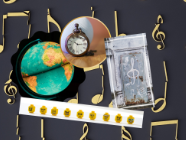 |
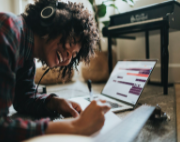 |
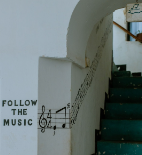 |
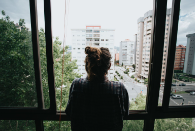 |
|
Focus of the Story |
We begin our year by studying music through time and place while building on previous knowledge to refine pitch, rhythm, technique, and literacy skills. We continue to grow as collaborators, communicators, and participators in diverse musical experiences. |
Our journey continues as we learn to identify, read, classify, and perform rhythms of increasing difficulty. Our knowledge of music history expands as we explore music from a variety of cultures and composers. |
The year continues as we relate career fields that are influenced by music and the science of sound. We apply our music literacy knowledge through student compositions and further develop our ability to analyze and evaluate our creations. |
We close out our year with opportunities to apply our knowledge more challengingly through composing, reading, and performing. Opportunities for assessing instrumental and vocal performances round out the year as we explore innovative ways to make music using technology. |
|
Transfer Goals |
Understand and apply creative processes to guide the development of ideas, original works, and musical performance. Analyze, interpret, and evaluate musical works from a variety of cultures. Understand and find meaning in music as a form of community engagement through involvement as a performer, supporter, advocate, and audience member. Use music literacy to demonstrate understanding of the elements of music and the ways they inform artistic performance and creative expression. Use technology as a strategic mechanism for improving music literacy and improving music performance. |
Understand and apply creative processes to guide the development of ideas, original works, and musical performance. Analyze, interpret, and evaluate musical works from a variety of cultures. Understand and find meaning in music as a form of community engagement through involvement as a performer, supporter, advocate, and audience member. Use music literacy to demonstrate understanding of the elements of music and the ways they inform artistic performance and creative expression. Use technology as a strategic mechanism for improving music literacy and improving music performance. |
Understand and apply creative processes to guide the development of ideas, original works, and musical performance. Analyze, interpret, and evaluate musical works from a variety of cultures. Understand and find meaning in music as a form of community engagement through involvement as a performer, supporter, advocate, and audience member. Curate a portfolio of accomplishments, experiences, and performance materials exhibiting oneself as an artist. Use music literacy to demonstrate understanding of the elements of music and the ways they inform artistic performance and creative expression. Use technology as a strategic mechanism for improving music literacy and improving music performance. |
Understand and apply creative processes to guide the development of ideas, original works, and musical performance. Analyze, interpret, and evaluate musical works from a variety of cultures. Understand and find meaning in music as a form of community engagement through involvement as a performer, supporter, advocate, and audience member. Explore and connect personal interests, experiences, and aspirations through vocation, advocacy, and arts patronage. Curate a portfolio of accomplishments, experiences, and performance materials exhibiting oneself as an artist. Use music literacy to demonstrate understanding of the elements of music and the ways they inform artistic performance and creative expression. Use technology as a strategic mechanism for improving music literacy and improving music performance. |
|
Learning Targets |
I can use musical language to describe my opinion of musical compositions and how people are participating. I can connect music to other things I am learning. I can use good citizenship to show appropriate audience and participant behavior in a music setting. I can work with my group to reach our goal. I can create a rubric for self-reflection. I can play written music. I can use proper playing techniques. I can play expressively. I can read and perform melodies and accompaniments. I can demonstrate an accent. I can identify and perform duple and triple meter. I can read, notate, and perform melodies and rhythms. I can describe expression in music. I can identify a Baroque composer and composition. I can use music vocabulary to compare and contrast a variety of musical styles. I can sing melodies with proper singing technique. I can perform choreographed and non-choreographed dances and other musical activities. |
I can identify treble clef pitches. I can read melodies on the treble clef staff. I can read and notate complex rhythms. I can use musical vocabulary appropriately to discuss compositions. I can improvise melodies and rhythms. I can identify multiple sources for listening to music. I can develop a list of questions to use in research. I can perform choreographed and non-choreographed dances and other musical activities. I can perform movements in duple and triple meter. I can use good citizenship to show appropriate audience and participant behavior in a music setting. I can work with my group to reach our goal. I can use proper posture to sing. I can sing notated melodies with expression, balance, and blend. I can sing in harmony. I can identify music and musicians from the Classical Era. |
I can compose. I can explain the purpose of developing a musical product from creation to performance. I can describe basic ideas in the science of sound. I can use music terminology to describe musical qualities. I can use appropriate and positive language to describe the quality of music. I can explore what inspires musicians to perform or compose. I can describe different careers in music. I can use musical vocabulary appropriately to discuss compositions. I can read melodies on the treble clef staff. I can read and notate complex rhythms. I can sing notated melodies with expression, balance, and blend. I can play written music. I can use proper playing techniques. I can play melodies and accompaniments expressively. I can read and perform rhythm patterns using various notes and rests. |
I can use music terminology to describe musical qualities. I can use appropriate and positive language to describe the quality of music. I can actively listen to music. I can create music using technology. I can use musical vocabulary appropriately to discuss compositions. I can read melodies on the treble clef staff. I can read and notate complex rhythms using sound and silence. I can use proper posture to sing. I can sing with expression, balance and blend. I can sing notated melodies. I can play written music. I can use proper playing techniques. I can play melodies and accompaniments with expression and proper instrument technique. |
String Orchestra Storyboard
Essential Question: How does our instrument become our musical voice?
|
Quarter |
Quarter 1 |
Quarter 2 |
Quarter 3 |
Quarter 4 |
|
Unit Title |
Do I choose the instrument or does the instrument choose me? |
Not only can I produce a sound but I can play seasonal music. |
Not only do we read the notes but we read AROUND the notes. |
Look at me! I’ve got this and am ready for more! |
|
Image Cue |
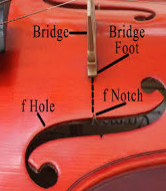 |
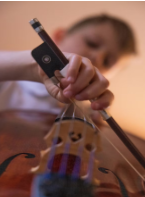 |
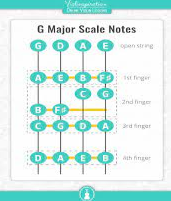 |
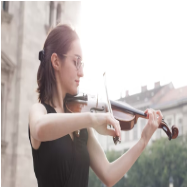 |
|
Focus of the Story |
Our learning begins with identifying the parts of our instrument and how to care for it. We practice handling our instruments safely and begin expanding our music literacy skills while learning how to produce sounds. |
We now focus on preparing for our first performance. Students will perform various musical selections that showcase beginning left and right hand techniques while reading and performing in the language of music. |
Next, our focus is improving our note reading and writing through scales while exploring pitches on new strings. We work to develop our tone and note-reading fluency while learning more challenging exercises. |
We end our year with solo and small ensemble music which requires increased and individual ownership of our instruments. We explore more challenging bow strokes and new scales as we demonstrate the ability to perform while focusing on posture, counting, and tone quality. |
|
Transfer Goals |
Understand and find meaning in music as a form of community engagement through involvement as a performer, supporter, advocate, and audience member. Explore and connect personal interests, experiences, and aspirations through vocation, advocation, and arts patronage. Use music literacy to demonstrate understanding of the elements of music and the ways they inform artistic performance and creative expression. |
Understand and apply creative processes to guide the development of ideas, original works, and musical performance. Analyze, interpret, and evaluate musical works from a variety of cultures. Understand and find meaning in music as a form of community engagement through involvement as a performer, supporter, advocate, and audience member. Explore and connect personal interests, experiences, and aspirations through vocation, advocation, and arts patronage. Use music literacy to demonstrate understanding of the elements of music and the ways they inform artistic performance and creative expression. |
Understand and apply creative processes to guide the development of ideas, original works, and musical performance. Analyze, interpret, and evaluate musical works from a variety of cultures. Understand and find meaning in music as a form of community engagement through involvement as a performer, supporter, advocate, and audience member. Explore and connect personal interests, experiences, and aspirations through vocation, advocation, and arts patronage. Use music literacy to demonstrate understanding of the elements of music and the ways they inform artistic performance and creative expression. Use technology as a strategic mechanism for improving music literacy and improving music performance |
Understand and apply creative processes to guide the development of ideas, original works, and musical performance. Analyze, interpret, and evaluate musical works from a variety of cultures. Understand and find meaning in music as a form of community engagement through involvement as a performer, supporter, advocate, and audience member. Explore and connect personal interests, experiences, and aspirations through vocation, advocation, and arts patronage. Curate a portfolio of accomplishments, experiences, and performance materials exhibiting oneself as an artist. Use music literacy to demonstrate understanding of the elements of music and the ways they inform artistic performance and creative expression. Use technology as a strategic mechanism for improving music literacy and improving music performance. |
|
Learning Targets |
I can explain and demonstrate correct instrument unpacking procedures. I can identify the parts of my instrument and bow. I can demonstrate and explain proper care of my instrument and bow. I can demonstrate a correct beginning bow hold. I can summarize important information about a Baroque composer. I can pull a straight bow on the D and A strings without playing over the fingerboard or bridge. I can demonstrate understanding of staff basics. I can demonstrate and perform consistently with correct left wrist and finger placement. I can demonstrate understanding of rhythm basics. I can write quarter note D and A on staff paper, with correct note head placement and stem directions. I can write counting for basic rhythm exercises and place bar lines correctly. |
I can consistently identify and perform all D and A string pitches on my instrument. I can consistently demonstrate and perform with correct left wrist and finger placement. I can consistently perform with a full bow stroke. I can identify all D and A string pitches on the staff, and consistently perform them on my instrument. I can clap, count, RWP rhythms with half notes and half rests. I can play 4th finger A on the D string (violin/viola) with I can read, write, and perform quarter notes in a D Major scale, pizzicato and arco, with correct posture and position in preparation for my Cornerstone Assessment. I can compose a 4-measure melody using quarter notes in the key of D major. I can demonstrate mastery of basic music theory terms and symbols on my Mid-Year Assessment. I can demonstrate proper stage, audience, and performance etiquette during a solo performance of my 4-measure composition. |
I can demonstrate understanding of staff basics. I can identify and perform G string pitches. I can demonstrate understanding of time signature basics. I can read and understand time signatures of 2/4 and 4/4. I can write countings for basic rhythm exercises using 8th note rhythms in 2/4 and 4/4 time and place bar lines correctly. I can identify and perform 1st and 2nd endings. I can clap, count, RWP rhythms with eighth notes, quarter notes/ quarter rests, half and whole notes/rest; adding dotted half notes. I can play 4th finger D on the G string (violin/viola) with correct intonation and left-hand shape. I can perform an ascending and descending G Major Scale using a teacher-selected rhythmic pattern, while playing arco, with correct posture and position, for my Cornerstone Assessment. I can compose a 4-measure melody using quarter notes in the key of G major. I can summarize important information about a Romantic composer I can demonstrate proper stage, audience, and performance etiquette during a solo performance of my 4-measure composition |
I can perform an ascending and descending D and G Major Scales using a teacher-selected rhythmic pattern, while playing arco, with correct posture and position, as class warm ups. I can write countings for basic rhythm exercises using 8th note rhythms in 2/4 and 4/4 time and place bar lines correctly. I can identify and perform 1st and 2nd endings. I can consistently perform my spring concert music and selected solo with correct left wrist and finger placement. I can consistently perform with a full bow stroke detache and 2-notes slurs. I can identify all D, A, and G string pitches on the staff, and consistently perform them on my instrument. I can clap, count, RWP all learned rhythmic notes/rest values. |
